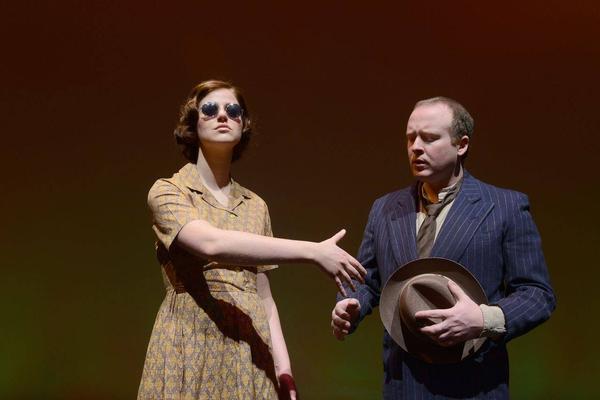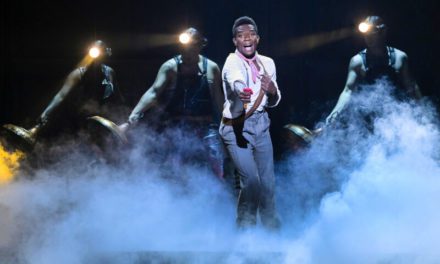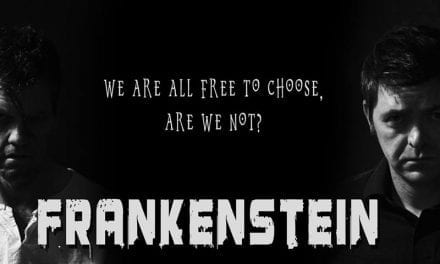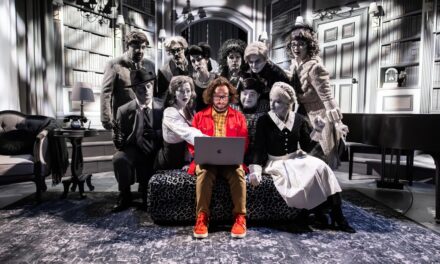SALT LAKE CITY — The Grand Theatre’s production of The Voice of the Prairie under the direction of John Caywood brings to the stage a complex plot featuring over a dozen characters and spanning thirty years performed by a cast of three on a stationary set. The story begins in 1895 and ends in 1923, but the journey is anything but straightforward. As the 1923 character David Quinn (David Hanson) finds himself as a storyteller for radio producer Leon Schwab (Jonathan S. McBride), his stories unfold on the stage in the form of the younger Davey (McBride), Frankie (Stephanie Purcell), and Poppy (Hanson). These characters bounce back and forth from recounting tales of the past, to living the historical scenes, to moving forward in time. Throughout the adventures, past and present, is woven a story of growing up, of freedom, and of love.

Show closes February 9, 2013.
At one point, Frankie describes the feeling of waking from a great dream or a nightmare, only to find upon sharing it that it has vanished. To try to describe this production feels very much the same way, as the triumphant moments and transcendent themes seem to slip between my fingers. So in case I stray from this point, let me say it up front and simply: this was an excellent production and well worth seeing.
Each of the actors deserves tremendous praise for bringing to life so many characters. It would be unfair to state only that I enjoyed each actor; rather, I enjoyed each character. I was particularly amazed at the ease with which each actor slipped into and out of his or her various roles, often after only a costume change as insignificant as a hat or a pair of glasses. In one instance, Hanson stepped out of the stage right scenery where he had been depicting a present-day David Quinn, and took five steps toward center stage. In those five steps, his posture changed entirely, and he became a completely different person.
Kyle Becker’s scenic design featured three main set pieces, each backed by a slatted, fence-like wall. The nearly monochromatic scenery featured faded logos of early 1900’s companies and was as functional as it was aesthetically appealing. Many of the character transitions took place behind the center wall. Because of the fence slats, it was possible to see the actors as they added jackets and aprons, removed hats, and became the characters required by the next scene. For a brief moment, I was distracted. Then I recognized this very unapologetic way of handling the frequent transitions, and I even came to appreciate the visual transitions to help me anticipate the next scene.
Each member of the production staff deserves praise for their various contributions, as there was no weak spot in this show. Spencer Brown‘s lighting design helped clarify the transitions and spotlighted the actors as they recited out of context lines to introduce the upcoming scene. Technical director Seth Miller and sound designer Joe Killian should be thanked for audio effects which supported the plot and for microphone levels that enhanced the intimate setting. Maire Nelligan’s props, Yancey J. Quick‘s hair and make-up designs, and Alyssa Edlund’s costumes all combined to create the reminiscent historical setting.
Under Caywood’s direction, this production set a very high standard for non-musical theatre. But it was not necessarily the production quality that makes this show a must-see. John Olive’s story itself was powerful and scripted in a way that almost demanded an emotional investment from me as an audience member.
It seems that the harder I try to capture the essence of this production with words, the faster it eludes me. If you enjoy historical fiction, if you relate to the emotions of a separated love, if you enjoy watching a story come to life on the stage, and even if you don’t traditionally enjoy non-musical plays, this story has a voice you should hear for yourself.

Stephanie Purcell and Jonathan McBride.





